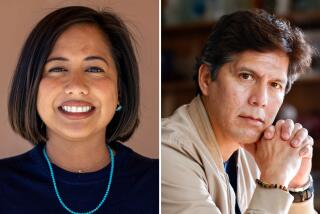Demographics Doom the Best-Laid Plans
- Share via
What the only Latino on the Los Angeles City Council, Richard Alatorre, is doing to the only Asian, Michael Woo, is sad, cynical and maybe even sleazy. But it’s not as terrible as Woo and other Asian-Americans are making it sound.
Alatorre has proposed a realignment of Woo’s 13th District to include more Latinos. That would make life tougher for Woo. But Alatorre is not laying the groundwork for a political war between the city’s two fastest-growing ethnic groups, as Woo claims. Nor is Alatorre creating another sure-fire Latino district for the City Council, as he might like us to believe.
This situation has come about, ironically enough, because of a federal lawsuit designed to increase minority representation on the council. The Justice Department sued Los Angeles last year under the Voting Rights Act, alleging that city leaders have deliberately diluted the voting power of Latinos, who represent 27% of the city’s population and yet hold only one seat on the council. In the hope of averting a costly court fight, the council asked Alatorre, who handled reapportionment when he was in the California Assembly in 1980, to redraw council district lines.
That gave Alatorre lots of power over the political futures of his 14 council colleagues. That he focused on Woo should surprise no one; he was an obvious and easy target. Woo has the least seniority on the council, except for Alatorre. And Woo was one of the few council members who would not support Alatorre’s effort to get himself appointed to a council vacancy last year rather than go through a costly election campaign. Now it’s payback time.
So Alatorre wants to take Hollywood out of Woo’s district and give most of it to Joel Wachs. That hurts. Woo gets financial support from well-to-do Hollywood hillside homeowners. He would keep Los Feliz and Silver Lake--not too shabby--but also would wind up with Lincoln Heights, from Alatorre’s neighboring 14th District. That would increase the Latino population in Woo’s district from 31% to 65%.
Woo is screaming foul, claiming that an Asian would be doomed in this proposed district. He is threatening a lawsuit of his own, and Asian-American political groups have rallied to his support. Some Latino groups that don’t like Alatorre’s plan may join them. They argue that Alatorre should have focused redistricting on other inner-city councilman like Gilbert Lindsay, who represents downtown, and John Ferraro, who represents the Wilshire District.
But things are not as bleak as they might seem for Woo.
First off, Latino population figures do not translate into voter turnout, because many Latinos are non-citizens or below voting age. Also, Alatorre would put Chinatown in Woo’s district, increasing his Asian constituency from 12% to 15%.
Woo can also take some comfort from history. In 1972, when the 14th District was first drawn up with a 67% Latino population, the incumbent councilman, Arthur K. Snyder, also complained. But he defeated every Latino who challenged him for the next 14 years. Except for personal problems that soured him on public life, Snyder would hold the job today instead of Alatorre. Woo can match Snyder’s record if he is willing to work at politics as Snyder did.
Woo might also look back at what happened in 1962, when the last Latino on the council, Edward R. Roybal, was elected to Congress. Roybal represented the 9th District, and urged the council to hold an election to pick his successor because there were several Latinos who wanted the job. Instead, council members appointed a black man, Lindsay, to the seat.
There are veteran Latino activists in this city who are still bitter about Lindsay’s appointment, which was rushed through at the end of an otherwise routine council meeting. The full story of that political deal has never been told, but council members claimed that the city’s changing demographics persuaded them to appoint a black councilman.
Indeed, the city was 40% black at the time, and there were no blacks on the council. Even Roybal acknowledged that his district was changing from mostly Latino to largely black. That is why Lindsay defeated a Latino challenger in the first election after his appointment.
Subsequent reapportionment has made Lindsay’s seat safer for a black candidate, but as insurance that process can only work so long. Right now Lindsay, like other blacks on the council, is scrambling to find district lines that will assure him of black voter support even as Los Angeles’ black population declines (it is now only about 17%) and as black neighborhoods on the Southside become Latino.
And it is worth noting that the Lincoln Heights neighborhoods that Alatorre is trying to foist onto Woo are changing, too. Asians are moving in as Latinos move out.
Just as changing demographics made some political careers, so they will undo others. That may not be palatable to Lindsay or other senior members of the City Council. And it won’t make the future any easier for newcomers like Woo and Alatorre. But that’s life in the big city.
More to Read
Sign up for Essential California
The most important California stories and recommendations in your inbox every morning.
You may occasionally receive promotional content from the Los Angeles Times.










